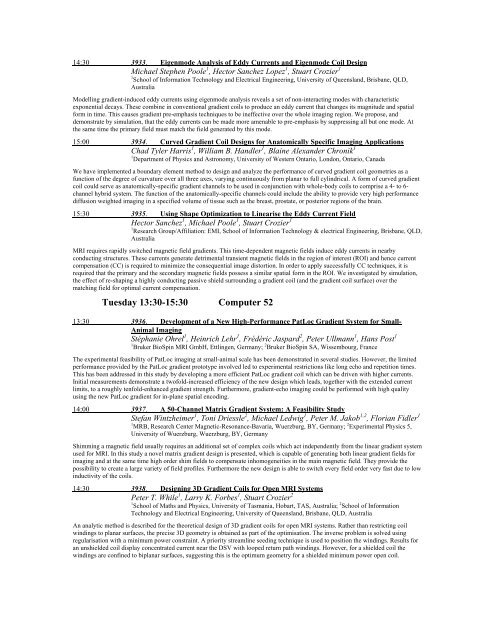ELECTRONIC POSTER - ismrm
ELECTRONIC POSTER - ismrm
ELECTRONIC POSTER - ismrm
You also want an ePaper? Increase the reach of your titles
YUMPU automatically turns print PDFs into web optimized ePapers that Google loves.
14:30 3933. Eigenmode Analysis of Eddy Currents and Eigenmode Coil Design<br />
Michael Stephen Poole 1 , Hector Sanchez Lopez 1 , Stuart Crozier 1<br />
1 School of Information Technology and Electrical Engineering, University of Queensland, Brisbane, QLD,<br />
Australia<br />
Modelling gradient-induced eddy currents using eigenmode analysis reveals a set of non-interacting modes with characteristic<br />
exponential decays. These combine in conventional gradient coils to produce an eddy current that changes its magnitude and spatial<br />
form in time. This causes gradient pre-emphasis techniques to be ineffective over the whole imaging region. We propose, and<br />
demonstrate by simulation, that the eddy currents can be made more amenable to pre-emphasis by suppressing all but one mode. At<br />
the same time the primary field must match the field generated by this mode.<br />
15:00 3934. Curved Gradient Coil Designs for Anatomically Specific Imaging Applications<br />
Chad Tyler Harris 1 , William B. Handler 1 , Blaine Alexander Chronik 1<br />
1 Department of Physics and Astronomy, University of Western Ontario, London, Ontario, Canada<br />
We have implemented a boundary element method to design and analyze the performance of curved gradient coil geometries as a<br />
function of the degree of curvature over all three axes, varying continuously from planar to full cylindrical. A form of curved gradient<br />
coil could serve as anatomically-specific gradient channels to be used in conjunction with whole-body coils to comprise a 4- to 6-<br />
channel hybrid system. The function of the anatomically-specific channels could include the ability to provide very high performance<br />
diffusion weighted imaging in a specified volume of tissue such as the breast, prostate, or posterior regions of the brain.<br />
15:30 3935. Using Shape Optimization to Linearise the Eddy Current Field<br />
Hector Sanchez 1 , Michael Poole 1 , Stuart Crozier 1<br />
1 Research Group/Affiliation: EMI, School of Information Technology & electrical Engineering, Brisbane, QLD,<br />
Australia<br />
MRI requires rapidly switched magnetic field gradients. This time-dependent magnetic fields induce eddy currents in nearby<br />
conducting structures. These currents generate detrimental transient magnetic fields in the region of interest (ROI) and hence current<br />
compensation (CC) is required to minimize the consequential image distortion. In order to apply successfully CC techniques, it is<br />
required that the primary and the secondary magnetic fields possess a similar spatial form in the ROI. We investigated by simulation,<br />
the effect of re-shaping a highly conducting passive shield surrounding a gradient coil (and the gradient coil surface) over the<br />
matching field for optimal current compensation.<br />
Tuesday 13:30-15:30 Computer 52<br />
13:30 3936. Development of a New High-Performance PatLoc Gradient System for Small-<br />
Animal Imaging<br />
Stéphanie Ohrel 1 , Heinrich Lehr 1 , Frédéric Jaspard 2 , Peter Ullmann 1 , Hans Post 1<br />
1 Bruker BioSpin MRI GmbH, Ettlingen, Germany; 2 Bruker BioSpin SA, Wissembourg, France<br />
The experimental feasibility of PatLoc imaging at small-animal scale has been demonstrated in several studies. However, the limited<br />
performance provided by the PatLoc gradient prototype involved led to experimental restrictions like long echo and repetition times.<br />
This has been addressed in this study by developing a more efficient PatLoc gradient coil which can be driven with higher currents.<br />
Initial measurements demonstrate a twofold-increased efficiency of the new design which leads, together with the extended current<br />
limits, to a roughly tenfold-enhanced gradient strength. Furthermore, gradient-echo imaging could be performed with high quality<br />
using the new PatLoc gradient for in-plane spatial encoding.<br />
14:00 3937. A 50-Channel Matrix Gradient System: A Feasibility Study<br />
Stefan Wintzheimer 1 , Toni Driessle 2 , Michael Ledwig 1 , Peter M. Jakob 1,2 , Florian Fidler 1<br />
1 MRB, Research Center Magnetic-Resonance-Bavaria, Wuerzburg, BY, Germany; 2 Experimental Physics 5,<br />
University of Wuerzburg, Wuerzburg, BY, Germany<br />
Shimming a magnetic field usually requires an additional set of complex coils which act independently from the linear gradient system<br />
used for MRI. In this study a novel matrix gradient design is presented, which is capable of generating both linear gradient fields for<br />
imaging and at the same time high order shim fields to compensate inhomogeneities in the main magnetic field. They provide the<br />
possibility to create a large variety of field profiles. Furthermore the new design is able to switch every field order very fast due to low<br />
inductivity of the coils.<br />
14:30 3938. Designing 3D Gradient Coils for Open MRI Systems<br />
Peter T. While 1 , Larry K. Forbes 1 , Stuart Crozier 2<br />
1 School of Maths and Physics, University of Tasmania, Hobart, TAS, Australia; 2 School of Information<br />
Technology and Electrical Engineering, University of Queensland, Brisbane, QLD, Australia<br />
An analytic method is described for the theoretical design of 3D gradient coils for open MRI systems. Rather than restricting coil<br />
windings to planar surfaces, the precise 3D geometry is obtained as part of the optimisation. The inverse problem is solved using<br />
regularisation with a minimum power constraint. A priority streamline seeding technique is used to position the windings. Results for<br />
an unshielded coil display concentrated current near the DSV with looped return path windings. However, for a shielded coil the<br />
windings are confined to biplanar surfaces, suggesting this is the optimum geometry for a shielded minimum power open coil.
















